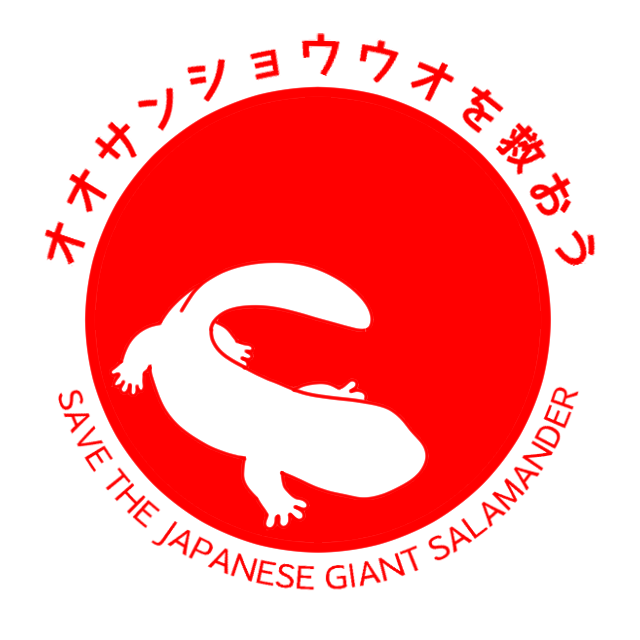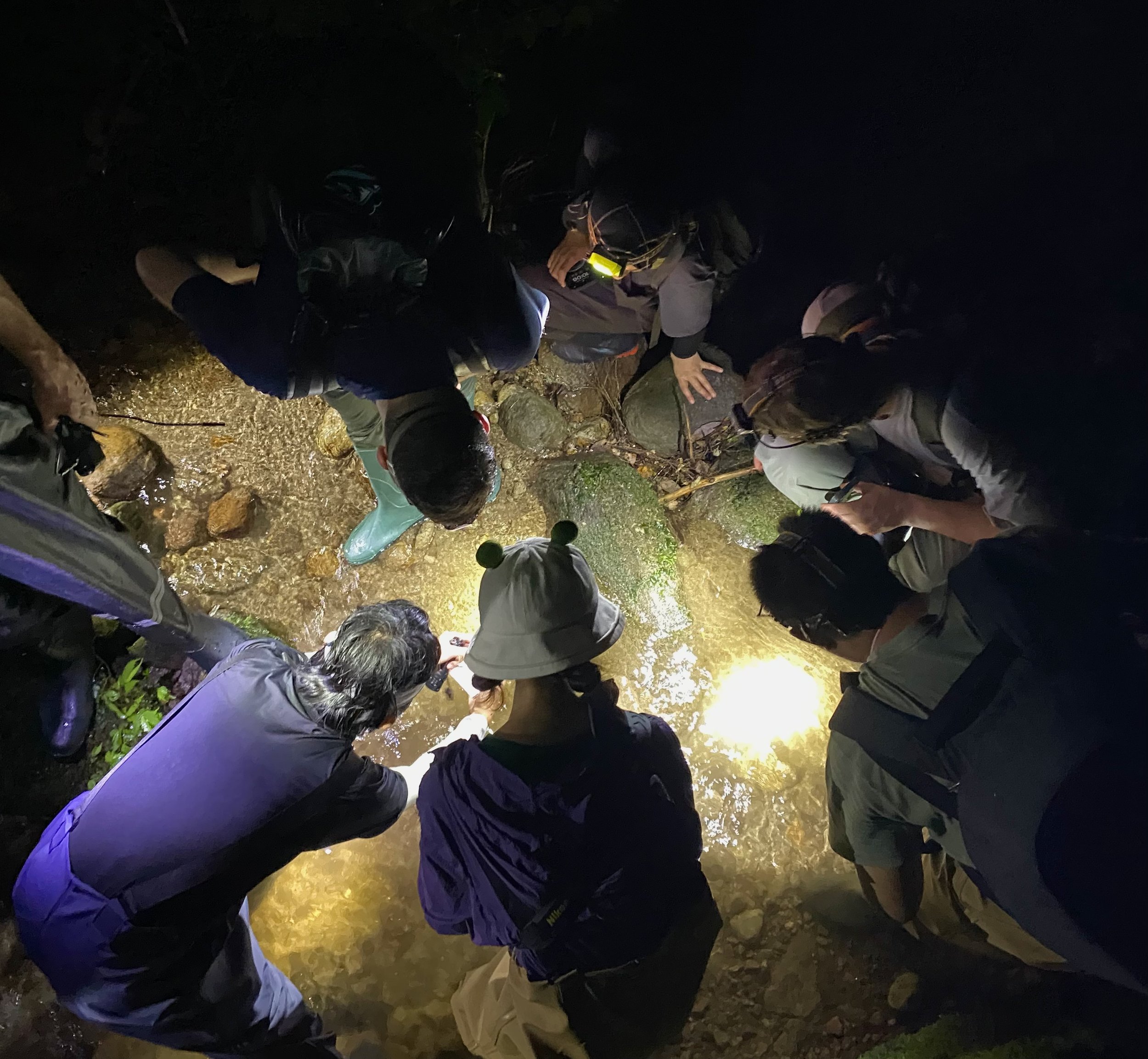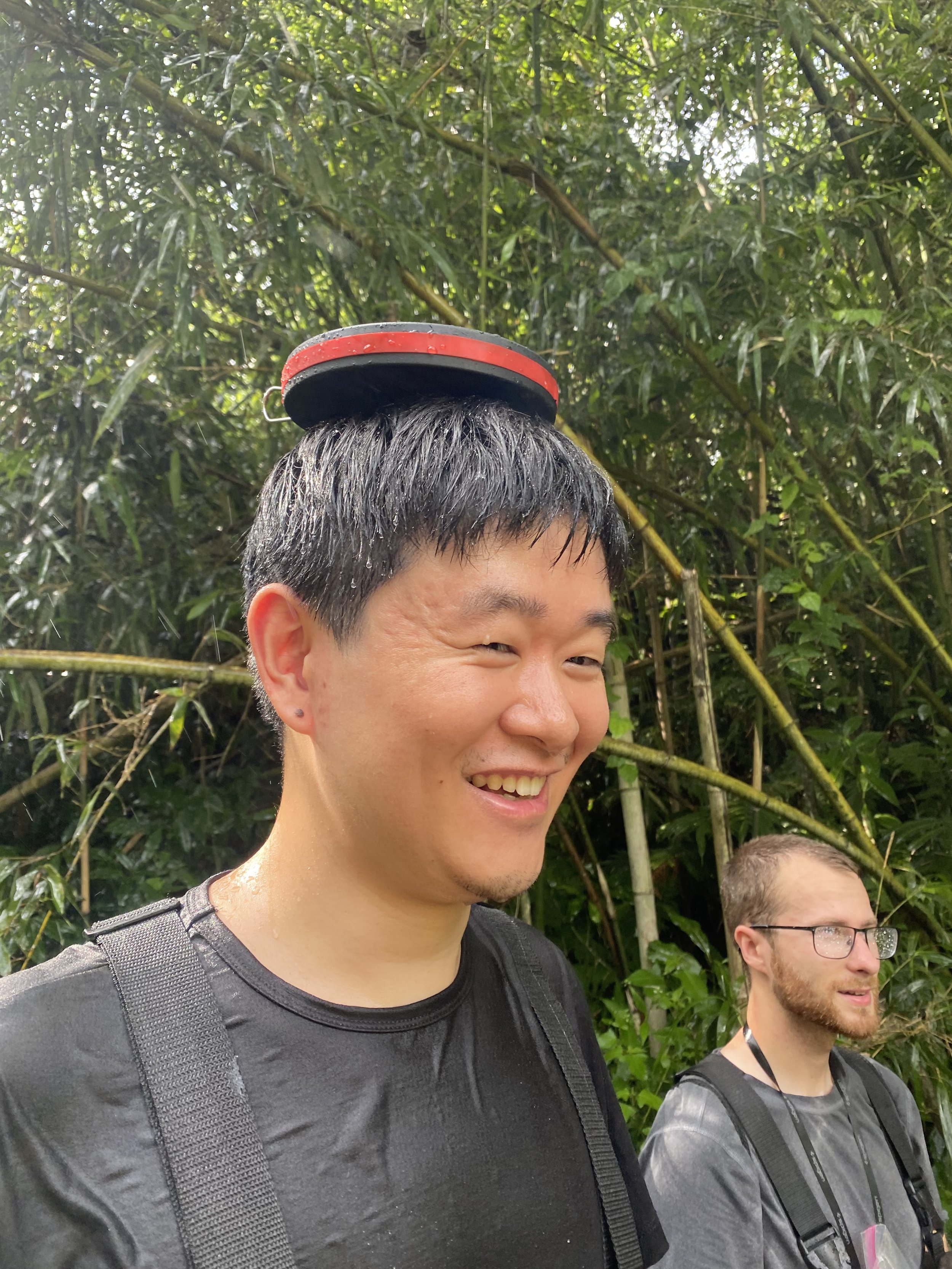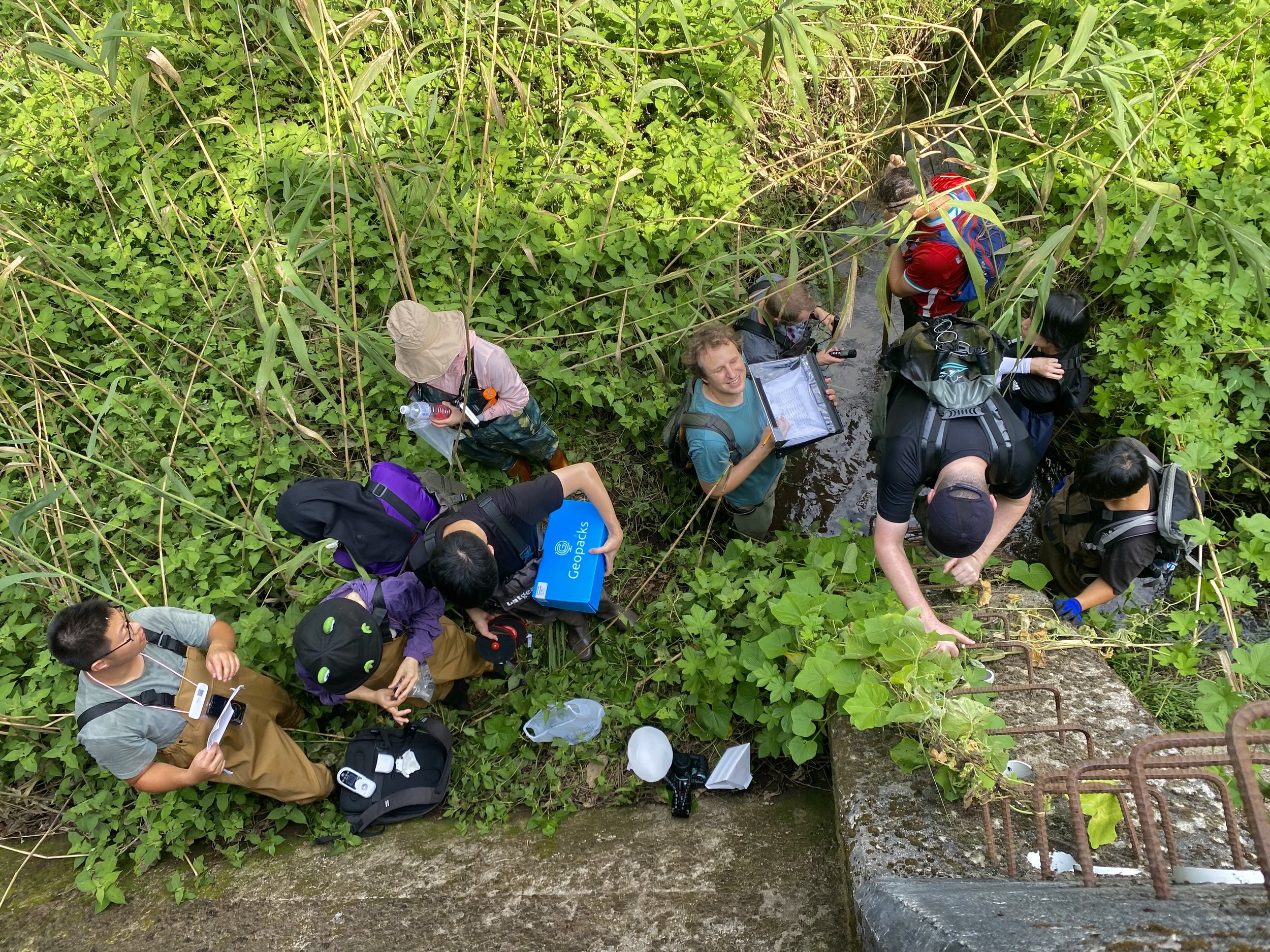Saving the Japanese Giant Salamander with Dr. Amaël Borzé and Dr. John Abernethy
By Francisco Garcia & Alyssa Torres
Amidst the lush landscape and tranquil streams of Daisen Town, Japan, a remarkable mission is underway. Sustainable Daisen joins forces with a team of sixteen international wildlife researchers for a profound ten-day expedition. The objective? To preserve the Japanese giant salamander, currently categorized as Vulnerable on the IUCN Red List. This vulnerability stems from multiple factors which include habitat loss, habitat degradation from governmental-installed weirs that obstruct habitat connectivity, and hybridization with the introduced Chinese giant salamander to name a few.
With the guidance of Sustainable Daisen's founder, Richard Pearce, the team endured many nocturnal, multi-hour treks in the Nawa river basin in search of these amphibious creatures and the potential presence of their Chinese counterparts. When a Japanese giant salamander is located, the team captures a clear photograph—a crucial element for their intriguing side quests—the development of AI software capable of identifying individual salamanders through photographic images. This AI technology will recognize the unique markings and features of a salamander's appearance, allowing researchers to identify the same individual in subsequent photos.
Kevin Messenger, PhD (front) and other team members capture photos for their AI project.
As each day ends, the team marks salamander locations for the following day's return under the sun. Armed with research equipment, they conduct comprehensive habitat surveys; a few of these tasks include water testing, eDNA analysis, and the documentation of nearby fauna with the help of iNaturalist. This data serves as a valuable resource for identifying threats, which will, in turn, aid us in devising solutions.
In this interview, we delve into the experiences, insights, and motivations behind two prominent figures at the forefront of this endeavor: Dr. Amaël Borzée and Dr. John Abernethy. Through their words, we'll uncover the intricacies of their profession, the significance of their mission, the encounters that left a mark, the obstacles they overcame, and the message they wish to convey to all who share a vested interest in our planet's biodiversity.
The team climbs over a weir during a Japanese giant salamander survey.
Can you tell me a bit about your background and expertise?
DR. AMAËL BORZÉE (AB): I am a behavioral ecology and conservation professor at Nanjing Forestry University. Most of my research and lab, with contributions from students, post-docs, and associate professors, consists of conserving wildlife in the greater Yellow Sea Basin. Meaning parts of China, north of the Yangtze River, Eastern Mongolia, a bit of Russia, DPR Korea, and the Republic of Korea. It's generally focused on amphibians, but we also do conservation for other animal groups when necessary.
I am also Co-Chair for the IUCN SSC Amphibian Specialist Group, an international organization, part of the International Union for the Conservation of Nature SSE. We provide knowledge and guidelines for the conservation of amphibians globally, and we just finished the global conservation action plans for amphibians around the world. Those are my main job positions: amphibian conservation and amphibian research.
Kyongman Heo (left) relaying habitat survey data to Dr. Amaël Borzeé (right).
DR. JOHN ABERNETHY (JA): I'm an Ecology and Environmental Sciences lecturer at Liverpool John Moores University. My primary focus lies in landscape ecology, where I examine the effects of human activity on habitats and how species respond and adapt to these changes. Currently, my research centers on how orangutans adapt to changes in the rainforest, including conservation efforts meant to restore their habitat. That's where I came from, and many of the methods I used then align with this project.
How did you go from the orangutans to giant salamanders?
JA: I started off loving amphibians and reptiles in my undergrad. I somehow fell into primates, and now I’m finally getting back into herpetology. I met Amaël during a conference in 2016 while deliberately trying to find people working in giant salamanders as it was a species I’d always wanted to work on. Somehow, I've managed to get to this point thanks to a lucky reply to one of Amaël's Facebook posts and then Richard seeing it and asking, "Do you want to come?" I said yes and decided to take the risk. Now, seven months later, I'm here.
Dr. John Abernethy holding a flow meter during a Japanese giant salamander habitat survey.
In the world of amphibian conservation, what are the main challenges these animals face?
AB: The main threat to all amphibians is habitat loss. For tree frogs, the breeding habitat is gone. For giant salamanders, it's habitat degradation because the habitat, in general, is there, but they cannot reach it. Also, climate change, It's a newly understood but serious threat. It has resulted in the shifting of suitable habitat and breeding phenology, with suitable habitat moving towards higher elevations or northwards in the northern hemisphere and southwards in the southern hemisphere. Changes in breeding phenology, or the timing of reproductive and developmental seasons, aren't aligning with the environment, resulting in resource shortages required for breeding and sustenance. Many amphibians must deal with this right before winter, an especially difficult time for survival.
With sixteen researchers working in sync, there must be some thrilling moments. Can you share a memorable experience from your time here in Daisen Town?
AB: Finding new things, especially that giant salamander larva with gills. Finding evidence of breeding was expected, but there hasn't been any recorded evidence of them still breeding here. So, that larva was both good and exciting. Also, we are finding some habitats that are in surprisingly good condition, which is a positive sign for their survival.
The researchers search for the skittish Japanese giant salamander larva.
It's fascinating that this endeavor brings together researchers from around the globe. Could you share your thoughts on the importance of international collaboration in conservation work?
AB: The species we work on don't follow any borders, and they don't need a visa to change countries. So, bringing experts and students with the right skills, independently of their nationalities is essential because these species transcend geographical boundaries. Collaboration is the only way. Otherwise, it would be exclusionary, elitist, and wrong because we wouldn't comprehensively understand the species.
Developing an AI to identify individual salamanders through photography sounds like quite the innovation. How will this technology contribute to the conservation efforts, and what inspired this idea?
AB: Well, we have the concept, and we understand the steps to make it happen, but we haven't created anything yet. We've gathered our salamander photos, and now our next step is to collaborate with a team experienced in AI software development.
Dr. JOHN ABERNETHY: We know wildlife conservationists who have done this kind of thing before, so we know it's possible. Our goal is to make it easier for Richard to keep track of the salamanders so we can eventually say, "This individual has been stuck in this section for `x` number of days."
AB: It would be super cool to track a salamander progressively moving downstream because we could see what artificial obstacles prevent it from returning upstream. If necessary, we can then pinpoint its origin and potentially bring it back to where it belongs so it can complete its life cycle.
JA: It would also provide evidence that when they get swept downstream, they become stuck there and are unable to regain higher ground.
AB: Right. We don't know if they can return on their own. Some might be because giant salamanders can go out of the water for a bit. In natural settings, they can navigate around obstacles like rocks or trees that have fallen in the stream. However, if you have artificial walls or barriers, like weirs, there's no way for them to circumvent these barriers. Further upstream, they might still be capable of finding alternative routes, but there's no evidence of this; it's more of a hopeful assumption.
I've been thinking, what happens if we move a stranded salamander up one weir? The next transect might be even shorter, so there wouldn't be much habitat available. So, what if we moved them two or three weirs upstream to expand their habitat? However, this raises concern because this new area might be affected by farm run-off, or have less food available as fish cannot move upstream either, so is it really better? Do we want to bring it to a place where the water may be of lower quality?
JA: But at least if we can identify the individual, we can monitor their health.
AB: That is true, but they ultimately should be able to freely move up and downstream. The salamanders naturally move upstream for breeding and then come down afterward to feed on large fish. This is essential for maintaining their health. Right now, they can only move downstream, which leads to death once they end up at sea level. So, finding a solution for them to return is imperative. In other parts of the world, some artificial ladders for salmon and other migrating fish have already been designed and implemented, and these would work perfectly for giant salamanders. However, implementing something like this would require government-level involvement.
JA: Yes, like the United States and Ireland, they've already adopted salmon and eel ladders. These ladders have a small side gate or sluice gate that allows salmon and eels to travel up the sides.
AB: These ladders don't need to be deep because these animals can spend some time mostly outside the water. They just require a bit of flowing water to create a sort of staircase, and then they can simply swim up. Salamanders can easily use them since they naturally follow the water's flow.
JA: There are actually some conservation groups that have designed giant salamander ladders, but they haven’t been implemented. So it is a known technology and this goal is within reach. The government just needs to spend a bit of money to build them.
AB: It's doable and not super expensive, but it needs some time because we'd need to build off the existing infrastructure.
A salamander walks under a cautious Alyssa Torres while researchers take photos of the animal for their AI software.
Regarding the development of your AI, what hurdles are you currently facing?
JA: Trying to wrap our heads around coding.
AB: I have no idea how to code.
You wouldn't get a third party to help?
JA: I do know people working on machine learning and camera traps at an organization called Conservation AI. They're currently working on using AI to automate the identification of species from camera traps. I'm planning on asking them for support but honestly, we're reaching out to and open to help anyone who has any kind of knowledge on this stuff.
As you capture data on the Japanese Giant Salamander's habitat, what specific aspects are you hoping to uncover that could contribute to their preservation?
AB: Needs. Environmental needs, ecological needs, food web needs, and so on. It's everything they require to survive that we may not know about. This data will show us what's lacking, and we can then supplement and provide this to help the species survive. For example, we've come across salamanders that look skinny. It's possible that some stream sections aren't healthy, which can lead to an insufficient amount of fish, an important food source for salamanders. By conducting a food web analysis, we can understand what's missing. As we discussed earlier, some of the habitat is inaccessible due to weirs. This blocks the salamanders from reaching breeding spots. They can be mature, healthy, and ready to breed, but they ultimately won't breed because of these artificial obstacles. So, it can be a lack of basic ecological requirements regarding space, resource accessibility, clean water availability, and suitable shelter based on the rock sizes and other factors we've been assessing.
Zhexin Qiu (left), Xioli Zhang (middle), and Dr. Siti N. Othman (right), gather water samples to test the quality of the stream.
In what way does your research address the impact of human activities on the salamander’s habitat?
AB: If there were no humans, we wouldn't have to do anything because their habitat would be good. So, in every way possible, everything we are working on is linked to human activities.
JA: Whether it's humans building weirs, modifying the shape of streams, or polluting the water itself, in every aspect, it's human influence. We're trying to understand the consequences these actions have on the giant salamanders so we can then build an action plan to help them.
The importance of preserving natural habitats grows as the world becomes increasingly urbanized. How do your findings impact urban planning and environmental policies?
AB: Basically, we need to modify the previous development so it does not negatively impact the species.
JA: It promotes the idea of sustainable development. Many of the developments in place date back to the 1950s and 60s, a time when nature and sustainability weren't significant considerations. We have to retrospectively think, "How can we improve this?" The lessons learned here could be applied to future projects, promoting more environmentally conscious practices like salamander ladders, water quality alerts, and preserving the natural shape of streams rather than excessive straightening.
Jordy Groffen, MSc gathers rock measurements for the salamander habitat survey.
The natural world is known for its surprises. Can you recount a challenging moment faced by the group during these ten days of intensive fieldwork?
AB: The long day…the streams are very long.
JA: Very long. They're also very rocky and uneven, with some sections being surprisingly deep, like deeper than the waders of some of our crew. During the long day, we had to crawl through a 200m long drain pipe on our hands and knees, that was the worst. I’m not a fan of small confined spaces, at some points I just felt like sitting there and crying, but I had a group behind me, so I had no choice but to keep moving. I was so glad to finally get out of there in the end.
AB: Mentally, it was exhausting because I had to constantly keep track of everything from everyone. I brought together a team to work on this project that Richard initiated, so I had to ensure that everyone was conducting their tasks correctly. This was a bit complicated since everyone has their perspective on how things should be done, and I owe it to the team to be respectful and patient, especially since everyone is investing their own time and money into this project. Naturally, some mistakes were made, which meant we had to go back out and recollect the data. If I had been more vigilant, we could have saved hours of work, but it wasn't easy, considering there were days when we'd be out till 2 or 3 in the morning. So, managing the team became my biggest challenge because one mistake potentially disrupted everything.
JA: We had equipment failing at times, which added to the stress. At one point, all of our flow meters broke, and luckily, once they dried off they fixed themselves. The pH meters were temperamental too.
AB: During the last reading, It was raining while I was using the pH meter. It's waterproof, so I assumed it would be fine, but once I finished and checked the value, it completely died. That was our last pH meter. Luckily, it was the final site we had to visit, and I managed to record the value right before it broke.
JA: The conditions have been harsh. Even though our equipment is built to work in water, it still manages to kill them.
Wan Le using a roll of measuring tape as an umbrella during a sudden downpour.
I'm curious about the day-to-day routine of a researcher on this mission. Could you give us a glimpse of what a typical day in the field looks like for you?
AB: We're usually working late the night before, so a typical day starts with us waking up at around 10 or 11 a.m. During our breakfast, we upload and review the data we collected earlier. This involves checking if everything is in order - the data sheets are in the right place, numbered correctly, dated accurately, and so on. We also ensure that our equipment is charged and has all necessary batteries. Then, we have a group meeting to discuss the day's plan. We make sure everyone understands their tasks, where to go, what data to collect, and how to handle potential issues. Some of our equipment is from China, so it’s easier to delegate those tasks to Mandarin speakers.
Once we're organized, we head out to the field. The locations vary depending on our tasks. Sometimes, we split into two teams; one collects data from the previous night's salamander survey, which takes us past sunset. The other team starts after sunset to begin a salamander survey for the next day's work. During the survey, we search for salamanders and pin the location of every one we find. We typically end between 1 and 3 a.m.
JA: After that, it's a late dinner at Lawson's, followed by a debriefing session. We'll also finish any remaining tasks or process the data collected during the day.
AB: Before bed, I charge all my equipment. After that, I start inputting all the wildlife I saw into iNaturalist until I fall asleep. This morning, I woke up and checked my phone to see what I was doing. I checked my screen, and I saw that I was in the process of uploading a "shark" observation. I can assure you that there are no sharks in the river. So yeah, it's been long, busy days where we're trying to cram as much work in as possible.
JA: If we're lucky, we might have a calmer morning, so people can catch up on laundry or grab food.
AB: Honestly, I haven't had the chance to pick up my own lunch.
JA: Yeah, the team has been looking out for you since you've been so busy being our leader for everything else.
AB: It's really nice, and I was so surprised when Jordy made coffee for me. I was in a rush that morning, and he said, "Here, take a seat," and offered me a fresh cup of coffee. It was so touching and very sweet.
The team gathers data and relays the information to Dr. Amaël Borzeé.
Do you have a love-hate relationship with fieldwork?
JA: Fieldwork, I love it, but then... Yeah, it's one of those things where, as you're in the midst of it, you feel exhaustion creeping in, and you start thinking, "God, I'm tired. I can't wait to leave." It's not hate; it's more like feeling really tired but really excited. Despite being completely shattered, you can't help but feel ecstatic. Today was a perfect example; I had an amazing day even though my feet are in absolute agony.
AB: Yeah, you were delighted today.
JA: I'm really giggly; I had a great day.
AB: You know when you're so tired that your stomach doesn't feel right, like you can feel the acid burning, and your brain is a bit foggy? I'm at this stage now.
JA: Yeah, I've only just passed that. Now I've come back and re-energized.
AB: I've been in the field since early March, so finishing tonight marks the end of five months of continuous fieldwork. I’m exhausted, but there is no hate. It's necessary work, and I can't do anything without it. But now, I'll be happily going home to my cat and a good cup of coffee.
JA: For me, I always look forward to fieldwork. I'm constantly trying to find opportunities to do it. At the same time, I'm looking forward to returning home, getting into a comfy bed, spending time with my partner, and just chilling out.
The team walks towards a rainbow that suddenly appeared during heavy rain.
As we wrap up, what message would you like to share with our readers to inspire their active engagement in conserving the Japanese giant salamander?
AB: Regarding the giant salamander specifically, they can donate and contribute to organizations like Sustainable Daisen or the ASG, which are more focused on giant salamander conservation. However, significant change also comes from a collective effort from the community to be more environmentally conscious. Animal agriculture has the largest negative environmental impact, so reducing beef consumption is a step in the right direction. We need to also address overpopulation, so thinking about having fewer children can make a significant difference in the future.
JA: It's essential to put pressure on policymakers for policy changes. In certain countries citizens can write to their representatives about environmental issues they witness, like river pollution or harmful farming and business practices. While it doesn't always lead to immediate change, it can create pressure and bring these issues to the forefront of representatives.
Joining and volunteering with a local conservation group is very helpful as well. If nothing is happening in your area, you can always set up your own group. Try to organize things like beach, river, and park clean-ups.
AB: I agree, but ultimately, large-scale change occurs when governments change policies and regulations. This responsibility falls on researchers and scientists who can draft law and policy recommendations. There's often an ivory tower mentality among some conservationists, where some believe that research alone is enough and they shouldn't get involved in conservation efforts. This is being complacent with the extinction of wildlife because working on policy recommendations must be done by everybody who can do so.
JA: Going on your point, I've come across many researchers who think, "I've done my research on conservation; I've published it. People can find it, and they can make their judgment based on it." But there's another side to this. Most people don't have access to these papers because it's either behind paywalls or not in normal English; it's in scientific English. Scientific language is complex and hard to understand.
AB: I have published conservation research papers, but I've also published conservation recommendations that have been translated into the right language for the right people. I've published three main policy recommendations. The first and third had no impact whatsoever. As for the second one, I can't definitively say if it made a difference because people never tell you the influence of such papers. In this case, we recommended a ban on the import of live amphibians with the potential to become invasive in South Korea. We engaged Korean officials and government members who had the authority to take action. Several months later, the law changed, and importing these amphibians became illegal. So researchers can make a difference, even if it might just be the straw that tips the scale
JA: Yeah, it's about everyone trying to do their part and trying to change the attitude of society. If you see something you don't like, you speak out, push people to do better, and remember that significant change requires a multifaceted approach. Researchers need to do their part, governments need to listen, and if it's safe to do so, people need to voice their concerns while also making individual changes to demonstrate a commitment to conservation.











